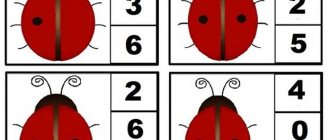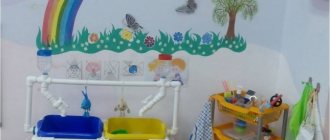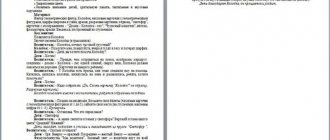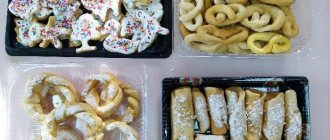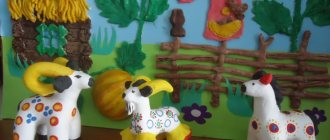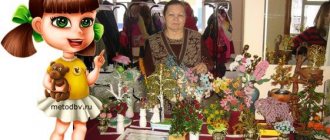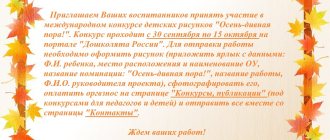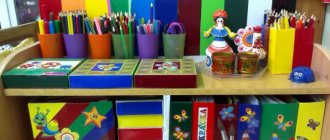General requirements for toys
Children in the younger group are very inquisitive and actively explore the world around them. They are interested in touching objects, examining them from all sides, breaking them and taking them apart. Many people do not miss the opportunity to taste the toy. Therefore, when arranging a garden, safety comes to the fore. Two- and three-year-olds do not always understand that something can harm them. Therefore, toys with small parts, sharp corners and loose elements are strictly prohibited. Make sure that the composition does not contain flammable or toxic materials. All parts should be easy to grip; there should be no splinters, burrs, or chips on the surface! “Talking” and musical games should not make too sharp or loud sounds. The maximum volume that is comfortable for a child’s ear is 70 dB.
What else you need to know about toys for younger preschoolers:
- They need to be selected taking into account the age characteristics of the children. If a child, due to his age, does not understand how to manipulate a complex toy (for example, a construction set with hundreds of parts or a controlled crane), then interest in it will quickly fade away.
- Toys should be multifunctional, broaden their horizons, and stimulate the child’s cognitive and research activity.
- They should evoke positive emotions, teach kindness and good deeds. No creepy monsters or characters with evil faces - this can provoke aggression, hysteria in children, and simply greatly frighten them.
Children spend most of the day in kindergarten. According to the Federal State Educational Standard, it is necessary to create for them a subject-spatial gaming environment that will not only be pure entertainment, but will also give an idea of the real world. Place your bets on popular self-learning toys. In the process of interaction, children intuitively understand how to handle them correctly. Such toys include aids based on the Montessori school method: sorters, lacing, busy boards, insert frames, wooden puzzles, boards, sensory bags, tactile books, etc. They help to learn about the main properties of surrounding objects (shape, size, color, texture), train logic, concentration and fine motor skills.
Provide easy access to toys in the playroom. They should be located in containers, boxes or on shelves at the height of children. For games with many small parts, consider packaging that closes tightly and securely.
What are the toys made of?
Let's look at the main materials from which children's toys are made for junior groups 1 and 2.
- Plastic. Typically this is polyvinyl chloride, polypropylene or polystyrene. A huge number of toys are made from plastic: cars, construction sets, cubes, sets of dishes, pyramids, sandbox accessories, vegetables and fruits, etc. Plastic has a rich color scheme, and the toys themselves are bright, often interactive and multifunctional. Plastic products are produced in Russia and in huge quantities in China. You need to be especially careful with Chinese-made toys, because plastic often contains components that are harmful to health: phthalates, phenols, heavy metals. When purchasing plastic toys for children in a kindergarten, be sure to check whether they comply with the requirements of GOST and SanPin. Such toys have a quality certificate and are marked “does not contain phenols or phthalates.” You can recognize a “harmful” toy by its pungent chemical smell, paint that stains your hands, or plastic burrs along the edges.
- Tree. For the production of games, species that can be easily processed are used: birch, beech, pine, etc. They are environmentally friendly and do not harm the child or the environment. Among the wooden toys there are many educational aids, puzzles, construction sets, puzzles - everything that develops motor skills and tactile sensations. Wood is heavier than plastic. By touching it, the child understands the real weight of the object: it takes some effort to lift and move the wooden figurine. Laconic toys that are not overloaded with details awaken the imagination and provide unlimited scope for imagination. If the toy is not painted, you can paint it together with the teacher or leave it in its natural form to see a cut of a real tree with growth rings and veins.
- Textile. Soft toys, puppet theater characters, cubes, and educational felt books are made from it. Fabric dolls must have a solid frame so that the body does not deform or bend during play. In a soft stuffed toy, the seams must be strong and neatly stitched so that the filler does not come out. Sharp objects, glass, cotton wool, and granules with a diameter of less than 3 mm are not allowed as filler.
Most toys combine different materials. For example, a bodyboard on a wooden base usually has metal locks and latches, plastic beads, fabric characters, laces, and zippers. Such a variety of textures, rough and smooth surfaces perfectly develop sensory experience, sharpen the accuracy and coordination of hands and fingers.
From 6 to 9 years
School-aged children love to play, which requires strategy and skill. Board games, outdoor sports, and classic toys like kites and trains are favorites. Children of this age also seek new information and experience through play, engage in creativity, and play with experiment and magic kits.
Bicycle and helmet Simple swimming equipment Skates, rollers, skateboard and safety equipment Construction sets Jump rope Figures Paper doll with outfits Sticker books Modeling kits Board sports Electronic games Dolls, clothes and accessories Dollhouses and furniture Board games Puzzles Experiment and trick kits
Interactive toys that talk to each other if you connect them with their tufts.
Toys for speech development in the younger group
From the age of 2, the child begins to enrich his active vocabulary, construct phrases, and attempt meaningful dialogue. Therefore, you need to pay attention to games for fine motor skills and manipulation of objects. Speech and motor skills are inextricably linked: the brain centers responsible for speech are located near the motor area. The best stimulants for speech development will be:
- sorters, labyrinths, lacing beads - train the accuracy of actions;
- business boards based on cartoons or fairy tales - develop imagination, imagination, teach how to play out scenes and at the same time interact with elements (open and close windows, rearrange a character in a train, etc.);
- musical toys: metallophones, xylophones - develop coordination, teach you to distinguish sounds, feel the rhythm, encourage you to hum a melody;
- folk toy matryoshka - introduces children to Russian folklore, promotes speech development with the help of riddles, counting rhymes, and nursery rhymes;
- cards with images of animals, objects, phenomena - each card can be examined and discussed what is depicted.
During the game, the teacher needs to talk through all the actions with the children, imitate the sounds of animals, speak slowly and clearly, and pronounce each sound. Kids like to repeat everything after adults, so they will happily pick up phrases and become participants in the “dialogue.”
From 1 to 2 years
Kids at this age are already full-fledged researchers. They want toys that encourage physical play—walking, climbing, pushing, and riding—and toys that encourage experimentation and manipulation. At this age, children love props and role-play that allow them to imitate adults, as well as toys that allow them to play alone.
The list of recommended toys for this age is completely similar to the previous one. Expand your stock of books and construction kits.
Wooden rainbow blocks will help develop the three senses: sight, touch and hearing. Set from Wonderworld.
List of toys for 1st junior group
Junior group 1 includes children from 2 to 3 years old. They are often restless and very active. Therefore, they need a constant change of activities so that active games alternate with “developmental games” that require concentration and perseverance. Wooden toys are a priority here: they are safe, understandable, and contribute to the development of imagination and creativity.
We have selected 10 toys that a group of little ones definitely cannot do without.
- Busy boards, especially thematic ones, based on fairy tales. Objects united by one theme are collected on one surface. This will allow children not only to develop tactile skills, but also to use their imagination, come up with scenes and stories with characters on the board.
- Wheelchairs - hone your sense of equilibrium and balance.
- Toys for stringing parts, tying or screwing: sorters with pins, pyramids, lacing.
- Large cubes with numbers and letters are the first steps to understanding mathematics and writing.
- Puzzles where you need to assemble a whole picture from 4-5 pieces.
- Insert frames with images of animals, transport, fruits, vegetables, etc.
- Simple wooden construction sets with 25-30 parts.
- Labyrinths with several challenging bead routes.
- Cut-out pictures and educational cards depicting letters, cars, fruits, vegetables, and various household items. In this case, the child compares the visual image in the picture with the spoken word. Having remembered, in the future he can easily say the name of this or that object.
- Balls, ring throws, sandbox sets, etc. everything for outdoor games.
During the lesson with toys, the first younger group only begins to engage in productive activities: drawing, design, attempts at story-based play. It is important for a kindergarten teacher to support these endeavors, take an active part in the game, and comment on the actions.
Where and how to post in a group?
Such items should be available in the garden. But this does not guarantee their proper use. They need to be marked correctly. We have several recommendations on this matter:
- The space needs to be divided into thematic zones. Most often there are 3 or 4 of them. The first zone is an imitation of a kitchen with the presence of toy dishes and household appliances. The second is an imitation of a bedroom where cribs with dolls are placed. The third zone is a screen in the form of a small house, where there are products in the shape of animals. The fourth is an imitation of the interior of a passenger bus.
- All objects that come into the toddler’s field of vision must be accessible. They can be placed on low racks, in mobile boxes, and plastic containers.
- Some entertainment attributes need to be made mobile. Their peculiarity will be that they can be used in different areas and can be easily transferred from one space to another.
Smart selection and practical placement of items will make the gameplay not only fun, but also useful. This approach will have a positive effect on the development of a 3-4 year old child. Toys will develop his fantasy, imagination, and orient him in space.
List of toys for 2nd younger group
The 2nd younger group includes children from 3 to 4 years old. Fine motor games are still important for them, but role play also appears in the activity. This is where toys come in handy, with the help of which kids come up with various scenarios and simulate real-life situations. Children learn to play together and show creativity. Therefore, to the previous list of materials for the first group we will add a few more:
- Calendar games on a wooden base. They are similar to busy boards, but their purpose is to teach the child to determine the time, day of the week, season. These manuals are bright and colorful, the numbers on the dial are clear, and the weather and season are indicated with a caption and pictures to make them easier to remember.
- Role-playing games on various topics: doctor’s and hairdresser’s kits, grocery baskets, household appliances, dishes. Girls like dolls and doll houses, boys like robots and fantastic animals.
- Lotto and dominoes. Promote the development of speech, memory and logical thinking. They are convenient to play with a whole group, but only under the supervision of a teacher.
- Various types of public transport and cars.
- Finger theater, hand puppets and folding theater screen.
Games that deepen knowledge about counting will be useful: business boards with numbers, abacus, counting sticks, fraction puzzles. Construction sets for the second junior group of kindergarten are much more complex; they contain more details and small elements.
Play equipment in the garden needs to be changed and updated regularly. Over time, any toys become outdated, worn out and simply boring. But competently equipping a kindergarten is only half of success and harmonious development. For young children, the most important thing is to introduce a new toy correctly. Try to clearly explain and clearly show how it should be handled. And most importantly, do not forget about safety rules and age-appropriate toys
Making game aids for children: master class
There are plastic bottles in almost every home. We will use them for the next tutorial.
Game "Flower Glade"
To provide yourself with everything you need to create such entertainment, take:
- a cardboard box with low sides, for example, for candies;
- plastic bottles;
- colored cardboard;
- scissors.
To make this game guide, cut out circles around the diameter of the bottle neck in a cardboard box, and cut out flowers from thick paper of different colors. Cut the necks of the bottles, insert each into its hole, and screw on the caps. The child will put flowers of the same color on them.
Here's how to play with your baby using these items. Tell him to:
- put flowers of the same color on the lids;
- I would put plants of a certain color in this impromptu flowerbed;
- I counted how many flowers and what color they came out with.
Game "Clothespins"
It will help the child develop his fingers, improvise, and come up with interesting stories.
For crafts, take plastic clothespins so that your child can easily squeeze them and put them on the object.
To make a game tutorial like this, take:
- cardboard;
- colored paper;
- markers;
- clothespins of different colors;
- scissors.
Making master class:
- Use templates or draw figures on cardboard: various funny animals, suns, clouds, flowers, people.
- Glue colored paper onto the cardboard and draw the characters' features using a felt-tip pen.
- Place the clothespins in the box. Let the child take them out and pin them: on the sun - rays, on a fish - fins, on a caterpillar - legs, on a cloud - rain, and so on.
It will be interesting for the child to come up with stories with these characters, and adults will help him with this.
Game "Feed the Animals"
Kids will also like this fun; it will also require clothespins. Children will learn what some animals look like and what they eat. To do this, you need to cut a circle out of cardboard, use a ruler and a thin felt-tip pen to draw segments on it. Glue or draw the following products into each:
- fish;
- nuts;
- carrot;
- bananas;
- grass;
- corn;
- bone;
- acorn.
On pieces of other cardboard, draw the following animals:
- cat;
- squirrel;
- hare;
- monkey;
- cow;
- mouse;
- dog;
- pig.
Pin a clothespin to the edge of each animal's face. Using this mechanical device, have your child place each animal next to the food item he or she is eating.
Tactile covers
For such an interesting game you will need:
- caps from baby food and plastic bottles;
- pieces of leather;
- scraps of various fabrics;
- glue;
- fur;
- scissors.
Cut out two circles for each type from various fabrics (silk, drape, fleece, flannel).
Now stick one blank from the pair on top of the lid, and put the second in a box or bag. First, show the child the fabric on the lid and let him touch it. Now, without looking, you can take a pair of circles out of a bag or box. In the same way, he will find a lid with pieces of fur and leather.
Finger Theater
This kind of fun helps children develop motor skills, hand coordination, thinking, and speech. You can make a finger theater that the child puts small characters on these parts of his hands. But you can make heroes in such a way that the child’s fingers temporarily turn into their feet.
The baby will surely be amused by how the character walks or runs briskly, thanks to the child.
As you can see, you need to cut out figures of people and animals from cardboard, stick colored paper on them, and paint the character so that it is clear who it is.
In place of each person’s legs, you need to cut out two equal circles. When it is necessary for a specific character to move, the child will insert his index and middle fingers here and “walk” with them.
This is how you can make a finger theater with your own hands.
